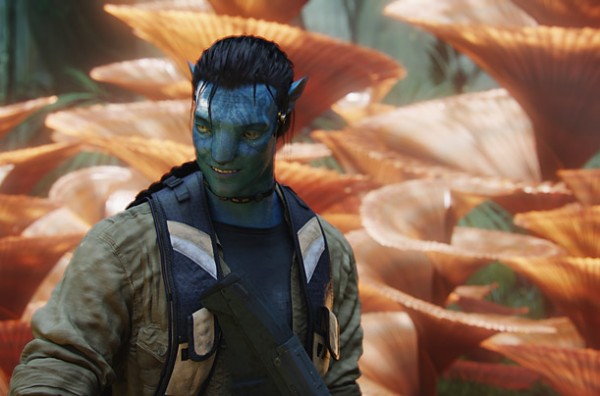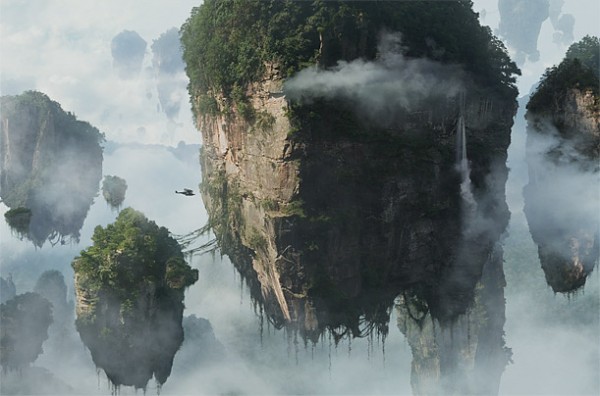
The message of James Cameron’s Avatar, which comes out on DVD and Blu-ray April 22 in conjunction with Earth Day, is unapologetically green. “All life on Earth is connected,” the director told in his interview that we have taken from nature without giving back, and the time to pay the piper is coming.” But Cameron took from nature, too. If the lush, alien jungles of Avatar feel eerily familiar, that’s because the director rooted them close to home. His muse for Avatar’s fictional moon, Pandora, and its wildly fantastical creatures, plants and landscapes was the planet Earth.
In May of 2005, before the film was greenlit by 20th Century Fox, a four-man team of designers began secretly creating Pandora in Cameron’s home in Malibu, Calif. The director gave them National Geographic photos, botany books and nature documentaries for reference. Says Neville Page, a concept artist and creature designer behind much of Pandora’s spectacle: “The best we could do was try to capture what nature has done so perfectly and expand on it.”
21 photos
On Pandora: Woodsprites
The Na’vi, Pandora’s blue inhabitants, consider these glowing, floating seeds sacred. They come from the giant, willow-like Tree of Souls, which connects to all living things on Pandora and directly to the Na’vi deity, Eywa. The seeds are not just blowing in the breeze, they’re traveling with spiritual purpose.On Earth: Deep-Sea Jellyfish
The woodsprites’ pulsating, almost hypnotic movement mimics the motion of deep-sea jellyfish, which Cameron saw while filming his underwater documentaries. But when Cameron first painted his woodsprites in the 1970s, he modeled them on the seed-bearing parachute of the dandelion weed. Back then he called them “dandelion things.”

On Pandora: Thanator
Even the Na’vi don’t mess with this rainforest predator, which inspired Sigourney Weaver’s character to yell, “Run! Definitely, run!” The Thanator has armored black skin, a massive head covered with red and yellow quills, and — lest you mistake it for a friend — 9-inch teeth.
On Earth: Black Panther
The Thanator owes its big, bad, toothy blackness to another forest-dwelling carnivore, the black panther, the melanistic wildcats found in Africa, Asia and Latin America. Its unusual armored skin comes from the insect world — it is hard, but pliable, like the chitinous texture of a caterpillar’s cocoon.
On Pandora: Mountain Banshee
The Na’vi ride the brightly colored, dragon-like banshees — so called for their piercing cry — through the mountaintops of Pandora. Banshees have four feathered wings with a 45-foot span. Each animal bonds with one Na’vi warrior in its lifetime, connecting with its rider through a bundle of nerve fibers called a queue.
On Earth: Archaeopteryx
Sometimes known as the “first bird,” the Jurassic-era Archaeopteryx was a major source of inspiration for the flying creatures in Avatar, including the banshee. The ancient creature is thought to be a transitional species between dinosaur and bird, since it has characteristics of both. In 2009, four years after the initial designs were made, a prehistoric bird fossil was found in China with four feathered wings, just as the banshee has.
On Pandora: Helicoradian
The spiraled orange leaf responds to touch by coiling up and sinking into the ground to avoid being eaten. The helicoradian is one of many kinds of zooplantae — part animal and part plant, or “planimals” — on Pandora.
On Earth: Christmas Tree Worm
These multicolored, cone-shaped worms live in the coral reefs of the world’s tropical oceans, where Cameron saw them while scuba diving. Like the helicoradian, Christmas tree worms are sensitive to movement and retract when touched.
On Pandora: Viperwolf
These six-legged, canine-like jungle predators move in packs and slink to the ground or climb up in trees when stalking their prey. Most creatures on Pandora are fierce or powerful — the closest Cameron got to cute and cuddly was his viperwolf pups.
On Earth: Mink
The lean body and graceful motion of the mink served as inspiration for the viperwolves. The minks’ movement — creeping so low as to almost disappear while hunting — was mimicked in the scene in which a group of viperwolves circle Sam Worthington’s character, Jake, in the forest.
On Pandora: Hallelujah Mountains
Pieces of these mist-covered, mesa-like mountains rip loose and float in the sky, like icebergs in the ocean. Waterfalls flow from the peaks, and straggly vines and ferns dangle off the sides. The humans in Avatar coined these the “Hallelujah Mountains” because they’re a source of unobtainium, a mineral sought after as a solution to Earth’s energy crisis.On Earth: China’s Huangshan
Like the Hallelujahs, the peculiarly jutting granite peaks of Huangshan in Eastern China’s Anhui Province are often shrouded in clouds. In this case, art followed reality, which then followed art: Officials in a separate area of China, in Hunan province’s Zhangjiajie, renamed one of their craggy peaks the “Avatar Hallelujah Mountain” to appeal to tourists.On Pandora: Prolemuris
This herbivorous monkey-like tree-dweller has two bifurcated limbs, which it uses to swing from branch to branch. Many of the animals on Pandora are hexapedal (they have six limbs), while the Na’vi have four — two legs and two arms. With its bifurcated arms, the prolemuris serves as an evolutionary link between the four-limbed Na’vi and the lower six-limbed species.On Earth: Ida, a Missing Link
The prolemuris was designed as a transitional life form, an idea borrowed from evolution. Scientists point to transitional fossils or “missing links” to illustrate an evolutionary change. One such link is “Ida,” a 47-million-year-old primate fossil found in Germany that bridges higher primates with lemurs. Though Ida has a skeleton like a lemur, she has opposable thumbs, like apes and humans.On Pandora: Direhorse
The Na’vi ride these calm, powerful, six-legged creatures, connecting with them through the queue. Direhorses grow to more than 13 feet in height, have a tough, plated hide and a long snout for drinking sap from Pandoran flora.On Earth: Clydesdale
Clydesdales, with their massive scale and strength, helped inspire the Direhorse. Designers also referenced the arched neck of Arabian horses and the gymnastic abilities of the Lipizanner breed.On Pandora: Hammerhead Titanothere
Twice the size of an African elephant, this herbivore has a massive, flat head, which it lowers when angry and ready to charge. When it wants to avoid a fight, the hammerhead raises a fan of brightly colored feathers on its head and roars.On Earth: Hammerhead Shark
The shape of the hammerhead titanothere’s head mimics the flat, laterally distended head of a hammerhead shark. Its large body and herbivorous diet are modeled on titanotheres, a family of extinct mammals related to rhinoceroses and horses.On Pandora: Neural Network
The trees on Pandora are connected by an electrochemical link that every living organism can access. A kind of organic superbrain, this neural network has 480 million more connections than the human brain. This is what the Na’vi consider their deity, Eywa.On Earth: Rat Dendrites
Pandora’s neural network is conceptually Cameron’s loftiest creation in Avatar. But visually, its model is a lot more humble — rat brains. The energy branches on Pandora connect to each other like the axons and dendrites of rat neurons.










0 comments:
Post a Comment